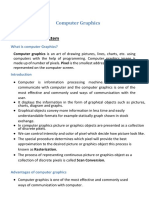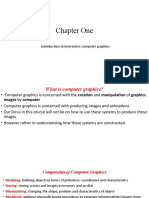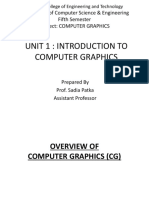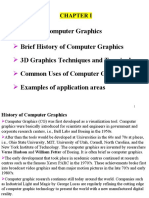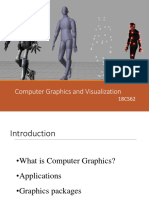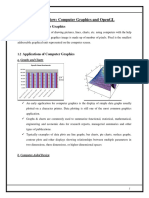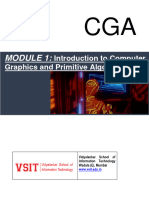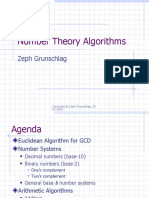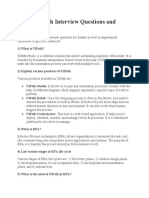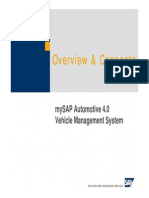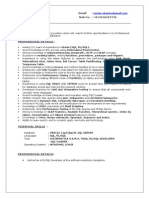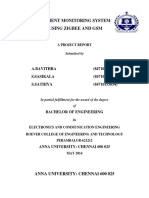Introduction to Computer Graphics (CS560/CS460)
Computer graphics means the art and science of creating images of three dimensional objects. Huge and Fast-moving field that integrates the best of art and science
�Introduction to Computer Graphics
Why Computer Graphics: - Commercial and industrial design
e.g., car model CAD (computer-aided design)
- Scientific presentation
e.g., researchers want to see the results of their theories and experiments presented as pictures
- Scientific visualization
e.g., statistics data, medical volume data, bio-chemistry data, etc.
- Commercial art and fine art
e.g., Animation, Television Commercials to feature films, Entertainment
- Graphical User Interface
e.g., Programming with quick and flexible manner; training and education; flight/driving training, virtual reality display; game
- Image processing and enhancement
e.g., computer-aided surgery
�Introduction to Computer Graphics
Topics in this course: - Basic conception and architecture - Raster Algorithm - Principle of 2D and 3D view - Principle of 2D and 3D transformation - Rendering (shading, illumination, texturing, ) - Modeling (curve and surface representation, ) - Animation - Virtual Reality Course work: - Programming intensive! - Math intensive!
�Basic Concepts
Computer Vision - simulate the human visual system, not only see the world, but also understand the world (image object) Image Processing - pre-process the image for better see or understand Pattern Recognition - classify and recognize both image content and some other statistic data. Computer Graphics - create or synthesize a virtual image objectimage)
�Basic Math
Algebra Computational Geometry E.g., R= [ ]*[ ] Interpolation and Approximation Bezier curves, spline curves, Physics based modeling
�Computer Model
MODEL: The way to describe and represent the object in the real world. Scale model - A scaled up (or down) copy of some object, usually built up from many smaller pieces, or surfaces to describe its shape. Mathematical model - A description of physical laws that describes the behavior of something.
Wire model (Line drawing) and Shaded model (shaded drawing) Static model and Dynamic model
MODELING: The way to create the model
Prepared modeling and Interactive modeling Subtractive modeling and Additive modeling (Solid modeling or Constructive modeling)
�Rendering
RENDERING: Creating the image as realistic as possible, representing the image in a high quality for visualization 2D Line drawing - line, circle, ellipse, text character, and other primitives 2D Image - area filled 3D wire-frame - 3D line, polygon
3D image - surface, shading, texture, transparency.
Data - Volume rendering
�Rendering
(Image Courtesy of University of Utah)
�Modeling
Modeling: Object representation Geometric representation - line, vertex, polygon, - curve, surface Mathematical representation - using mathematical equation to describe the object and scene Special effects/shape presentation - surface details and texture/lighting, or dynamic modeling
�Animation
Animation: Motion or Movement Animation generation
- Hand-painted process: very time-consuming - Key-Framing: Interpolation - Dynamics system: make your motion as physically correct as realistic as possible - Procedure motion: programmed motion (simple, but not realistic) (e.g., if then)
�Animation
Animation: Motion or Movement Human Visual System: Persistence of Vision
- When you are shown a picture, it tends to be retained in your minds eye for a very brief period of time - If the pictures are shown quickly enough, one after the other, then the new picture arrives before the old one fades, and you perceive a smooth movement. - Persistence of vision is what allows conventional file, video, and animation to provide a successful illusion of movement.
Projection rate
- film: 24 frames/second - video (television): 30 frame/second
�Animation
(image from book Computer graphics principles and practice by Foley, Van Dam, Feiner and Hughes))
�Animation
WARPING: Image transformation Geometric transformation - linear, non-linear
Object deformation - automatic, interactive
Special effects presentation - arts, entertainment. MORPHING: Image transition
�Warping and Morphing
(Image Courtesy of Heckbert and Hanrahan NYIT))
�Virtual Reality
VIRTUAL REALITY: Stereo display Dynamic display (left-eye and right-eye display alternatively) - simulate the real world, give you the real feeling
Head-Mounted display
�Virtual Reality
(image from book Computer graphics principles and practice by Foley, Van Dam, Feiner and Hughes))
�Recent Development
1. Characteristics: Fast and Realistic and interactive Architecture: Parallel algorithm Display: Advanced raster algorithm with antialiasing, surface simplification, large amount of data rendering (volume rendering) 3D Modeling: Image based and physics based 3D Animation: Key frames, dynamics, procedure motion capture. Warping and Morphing: Special effects. Virtual Reality: CAVE 3D stereo display
�Computer Graphics Programming
MS Windows: Visual C++, or Visual Studio .Net Unix, Linux, Irix: C and C++ OpenGL and Mesa GLUT
�Computer Graphics Workstation
Hardware (Physical System) INPUT - Keyboard, Image digitizer OUTPUT Softcopy (display) Hardcopy(printing) - Text CRT (Cathode-Ray Tube) - Printer, Color raster Monitor, Film/Video recorder - Calligraphic CRT (vector monitor), Plotter - Head-Mounted display (HMD) (stereo) TRACKER - Data Tablet (absolute positioning) - Stylus/Pen (absolute positioning) - Puck (absolute positioning) - Mouse (relative positioning) - Joystick - Trackball - Space Tracker (3D position and orientation) - Hand Tracker
�Example (Demo)
�Multi-Media Messaging with Individualized Talking Avatars
�Appliations
�References
Text books: (1) D. Hearn and M.P. Baker, Computer Graphics with OpenGL. Third Edition, Prentice Hall 2004 (ISBN: 0-13-015390-7). References: (1) Computer graphics: Principle and Practice (2) 3D computer graphics: A users guide for artists and designers (3) OpenGL reference menu (4) Principles of three-dimensional computer animation Journals: IEEE Transactions on Visualization IEEE Computer Graphics and Applications Graphical Model and Image Processing Computer & Graphics The Visual Computer Conferences: SIGGRAPH (ACM Transaction on Computer Graphics) Proceedings of Computer Graphics International EURO Graphics Internet: http://www.sgi.com http://www.opengl.org/ http://techpubs.sgi.com/library/ http://reality.sgi.com/opengl/spec3/spec3.html http://codeguru.earthweb.com/opengl/GLDIB.shtml http://devcentral.iftech.com/learning/tutorials/mfc-win32/opengl/2.asp http://ask.ii.uib.no/ebt-bin/nph-dweb/dynaweb/SGI_Developer/OpenGL_PG/

























